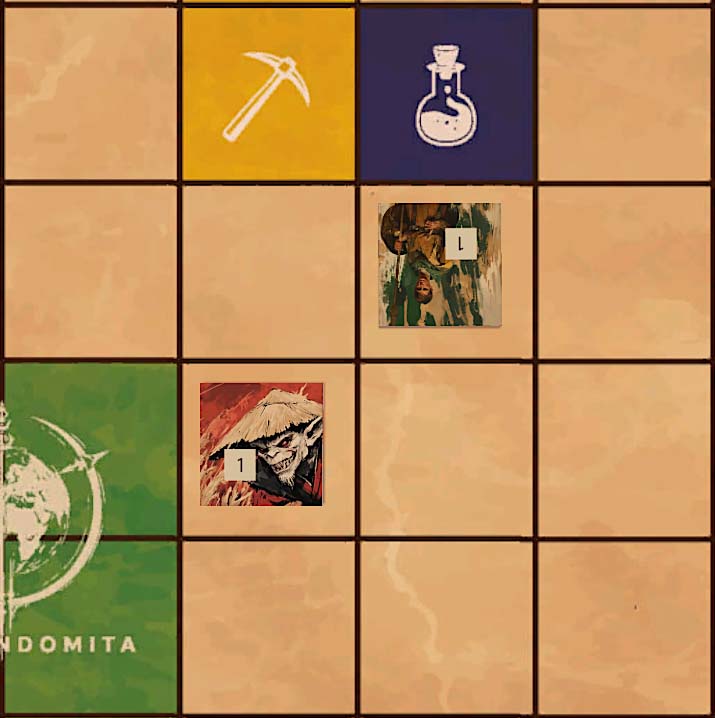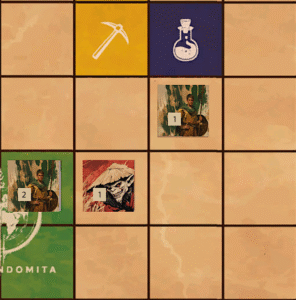Rules Detailed
Anatomy of a Turn
Each turn in Terra Indomita follows a structured sequence to ensure smooth gameplay and strategic depth. The turn is divided into six main phases, with each phase allowing specific actions and interactions.
1. Turn Start
Timing Breakdown:
- Resolve any “When turn starts” triggered abilities and reactions.
2. Restore Phase
- Resolve any “When Restore phase starts” triggered abilities and reactions.
- Refresh all depleted units and cards.
- Resolve any “When Restore phase ends” triggered abilities and reactions.
3. Draw Phase
- Resolve any “When Draw phase starts” triggered abilities and reactions.
- Draw one card.
- Resolve any “When Draw phase ends” triggered abilities and reactions.
4. Collection Phase
- Resolve any “When Collection phase starts” triggered abilities and reactions.
- Set current player’s Mana to 0.
- Collect Gold and Mana from occupied nodes.
- Resolve any “When Collection phase ends” triggered abilities and reactions.
5. Action Phase
During the Action phase, the active player can perform any number of the actions, assuming they meet all the requirements.
Actions Available:
- Activate a Unit – Choose a unit to activate. It is considered “Active” until it is depleted. It may take a Movement and Attack action in any order before being depleted:
- Movement Action: Move squares up to its movement value.
- Attack Action: Attack a target unit that is within range.
- After acting, the unit becomes depleted until the next Restore Phase.
- If a unit is depleted while “Active”, its active state ends and the current player must move on to their next Action. (For instance: The current player might move their Centurion Mage then use it’s Activated Ability by Depleting and paying 1 mana to deal 3 damage to a unit within 4. When this happens the unit’s Active state ends and the current player cannot then attack. This also means the Centurion Mage cannot use its Activated Ability and move after.)
- Play a Card – The player may place or play:
- Units (adjacent to their base or via special effects).
- Buildings (adjacent to a worker).
- Equipment (attached to a unit).
- Research (adjacent to a controlled Mana node).
- Spells/Abilities (following their casting rules).
- Activate a Card’s Ability – Some cards have reusable abilities that can be triggered.
- Place a Worker – A player may place one worker per turn.
- Pass to end turn and move to Cleanup Phase.
Timing Breakdown:
- Resolve any “When Action phase starts” triggered abilities.
- Perform Actions
- Resolve any “When Action Phase ends” triggered abilities and reactions.
6. Cleanup Phase
- Resolve any “When the Cleanup phase starts” triggered abilities and reactions.
- Remove any “until end of turn” effects.
- Discard down to 8 cards if necessary.
- Resolve any “When the Cleanup phase ends” triggered abilities and reactions.
7. Turn End
- Resolve any “When turn ends” triggered abilities and reactions.
Action Queue
Terra Indomita uses a system similar to other card games based on the “Last In, First Out” rule.
- The player whose turn it is has has priority during each step of the turn.
- When any action is taken, even a triggered ability, an Action Queue is created, priority then shifts between players before the action resolves in First In Last Out order.
- Only actions that occur at “Reaction” speed can be added to the Action Queue.
- Actions can further be added in response to steps of the Action Queue resolving. For instance after the first action resolves players can re-add to the Action Queue before it resolves further.
Action Queue Example:
- Player A has priority and declares unit X will Attack unit Y. This creates the Action Queue with the 1st position being the Attack.
- Player B now has priority and responds with the ability “Source Armor” to give unit Y additional Damage Reduction. Source Armor is in the 2nd position.
- Player A now has priority and responds with the ability “Heavy Strike” to give unit X double damage on its attack. Heavy Strike is in the 3rd position.
- Player B then passes. Player A then passes. With all players passing the Action Queue begins to resolve.
- The Action Queue at this time looks like:
- Attack
- Source Armor
- Heavy Strike
- It will resolve in opposite order i.e First In, Last Out:
- Heavy Strike
- Source Armor
- Attack
- Once all actions resolve, Player A resumes priority as it is their turn.
Reaction Speed
Reaction speed abilities and effects occur instantly when their requirements are fulfilled and can occur even during another person’s turn. These are either added to a current Action Queue or create a new one when used.
- Ability Reaction Cards – Ability cards with the subtype “Reaction” can be played anytime a player has priority, even during an opponent’s turn.
- Triggered Abilities – Abilities that activate automatically when a condition is met, regardless of priority. (e.g., “When this unit is attacked: Draw a card”). The condition (When this unit is attacked) is the part prior to the colon and the effect (Draw a Card) is the part after.
- Active Abilities – Activated Abilities are abilities listed on cards that require some type of payment to be used. These can also be used any time a player has priority. (e.g., “Deplete: Move this unit 2”) The part prior to the colon is the “payment” (Deplete) and the part after is the “effect”
Triggered Abilities Examples:
- “When your turn starts: Draw 1 card.”
- “When an enemy unit is placed: Deal 1 damage to it.”
Active Ability Examples:
- “Deplete: Draw 1 card.”
- “1 mana: Deal 1 damage to target unit.”
Zone of Control (ZoC)
Every unit (unless specified otherwise) has a Zone of Control (ZoC)—all adjacent squares around it.
- If an enemy moves into a ZoC, it immediately stops moving.
- If a unit begins its turn in an enemy’s ZoC, it can move freely within and out of it. Additionally, if it moves out and moves back in it stops moving.
Exceptions:
- Abilities that ignore movement penalties.
- Units with special movement mechanics.
Adjacency Bonuses
An important aspect of combat is Adjacency Bonuses. It represents the disruption caused by enemy units or the assistance of allied units. Whenever a unit attacks another unit you calculate attacker and defender adjacency.
To calculate Attacker Adjacency Bonus simply add up all the units allied with the attacking unit who are adjacent to the defending unit. This number is added to the attacking unit’s damage.
To calculate the Defender Adjacency Bonus simply add up all the units allied with the defending unit who are adjacent to the defending unit. This number is subtracted from the attacking unit’s damage.
Example 1
In this first example the Goblin #1 is attacking the Levy #1, no allies are adjacent so there is no adjacency bonus. The Goblins deals 1 damage to the Levy.

Example 2
In this example Goblin #1 is attacking Levy #1. Levy #2 is adjacent to the attacking Goblin, reducing the Goblin’s damage by 1. In this example, the Goblin will deal no damage.

Example 3
In this example Goblin #1 is attacking Levy #1. Levy #2 is reducing the damage of the attacking Goblin by 1 while Goblin #2 is providing adjacency and increasing the Goblins attack by 1. In this instance the Goblin will deal 1 damage.
Combat: Attack Calculation
When a unit attacks, follow this calculation:
Total Damage = Attack’s Base Damage + Modifiers + Total Adjacency Bonus
Damage is dealt by putting Damage Counters on the unit. This is tracked with a dice on either the card or tile depending on preference.
Economy & Resource Management
In Terra Indomita, efficient resource management is key to victory. Players must carefully balance their Gold and Mana income, strategically deploying workers and leveraging their faction’s abilities to maintain an advantage.
1. Resources: Gold & Mana
There are two primary resources in the game:
- Gold – A persistent resource used to purchase units, workers, buildings, and equipment.
- Mana – A volatile resource used to cast spells and research powerful upgrades. Unlike Gold, Mana resets to zero at the start of each turn.
At the beginning of a player’s turn, they collect resources from the nodes their workers occupy.
Gold Collection
- Gold Nodes provide 1 Gold per worker stationed on them.
- Gold accumulates turn over turn and can be saved for later use.
- Certain abilities, research, and buildings can modify Gold income or efficiency.
Mana Collection
- Mana Nodes provide 1 Mana per worker stationed on them.
- Mana resets to zero at the start of every turn, meaning players must spend it wisely before their turn ends.
- Certain units, buildings, and research can enhance Mana generation or efficiency.
2. Workers
Workers are essential for gathering resources. Each turn, players may place one worker during the Action Phase. Some cards or abilities allow additional workers to be purchased or played.
Worker Stats
- Health: 1
- Damage: 0
- Movement: 3
Worker Rules
- Placement: New workers are be placed adjacent to their base.
- Movement: Workers can move up to 3 spaces per turn.
- Resource Gathering: A worker must be on a resource node at the start of a player’s turn to collect resources.
- Vulnerability: Workers can be attacked by enemy units.
- Limited Per Turn: Players can only place one worker per turn.
- Unit: Workers are considered units.
3. Nodes
Nodes are critical points on the battlefield, providing resources each turn. Controlling more nodes gives a strategic advantage.
Node Types
- Gold Nodes
- Provide 1 Gold per worker stationed on them.
- Players may contest Gold Nodes by removing enemy workers through attacks.
- Mana Nodes
- Provide 1 Mana per worker stationed on them.
- Unlike Gold, Mana resets to zero each turn, requiring precise planning.
Node Control Rules
- Workers must be present at the start of the Collection Phase to generate resources.
- Workers on nodes can be targeted and destroyed on nodes .
- Nodes cannot be occupied by more than one worker at a time.
- Only workers an move onto a node.
Cards & Deck Construction
In Terra Indomita, your deck determines the units you deploy, the spells you cast, and the buildings you construct. Crafting a well-balanced deck is essential to developing a winning strategy.
1. Anatomy of a Card
Each card contains key information that dictates its function in the game. The main components of a card are:
- Faction – Indicates which faction the card belongs to, such as Voltaire, Taqla, Sacrony, or Fjordn.
- Card Type – Defines the role of the card, such as Ability, Equipment, or Building.
- Subtype – Provides additional classification that affects interactions, such as Infantry, Hero, Research, or Fire Spell.
- Card Text – Lists the abilities, effects, and conditions of the card.
Cost System
- Gold Cost – The amount of Gold required to play the card.
- Mana Cost – The amount of Mana required to play the card.
2. Unit Cards
Units represent the troops and creatures you command on the battlefield. When a unit card is played, a corresponding unit tile is placed on the board.
Unit Stats
Each unit has a set of attributes that define its battlefield effectiveness:
- Health – Determines how much damage a unit can take before being destroyed.
- Movement – Determines how far the unit can travel across the board each turn.
- Range – Defines how far the unit can attack.
- Damage – The amount of damage a unit deals when attacking.
Unit Placement
- When a unit is played, it is placed adjacent to the player’s base unless another ability allows placement elsewhere.
- If a unit is destroyed, its tile is removed from the battlefield, and the card is placed into the discard pile.
3. Building Cards
Buildings provide permanent effects and structural advantages to a player’s strategy.
Building Placement Rules
- Buildings must be placed adjacent to a worker.
- Buildings cannot be placed within two squares of a base or the board edge.
Building Stats
- Health: 1
4. Equipment Cards
Equipment cards attach to units, granting them additional stats or abilities.
Equipment Rules
- Equipment remains on the unit until the unit is destroyed or the equipment itself is targeted and destroyed. In either instance, the equipment card is placed in the discard.
5. Research Cards
Research cards provide permanent upgrades and grant new abilities.
Research Rules
- Research cards require Mana to be played.
- Once placed, Research remains in effect until removed by an effect.
- Research cards are placed adjacent to a controlled Mana node.
6. Spell & Ability Cards
Spells and Abilities provide powerful one-time effects or special actions for units.
Spell & Ability Rules
- Abilities are always cast by a unit, workers can also be considered a caster for an ability as long as they meet any requirements.
- Spells require a unit with a matching magic school, such as Necromancy or Evocation, to cast.
- Ability cards can be played when the player has priority on their turn and there is not an active Action Queue.
- Ability cards with the Reaction subtype can also be played any time the player has priority.
7. Permanent Cards
Some cards remain in play indefinitely until removed by an effect. These include:
- Buildings – Unique structures that provide powerful, often game-changing effects.
- Research – Permanent upgrades and technological advancements.
- Equipment – Attaches to a unit and remains until the unit is destroyed.
- Units – Stay on the battlefield until defeated.
Unique & Hero Units
- Players may only have one copy of a Hero unit or Unique card in play at a time.
- Playing a second copy immediately destroys the original version.
